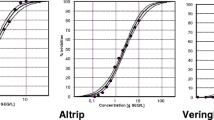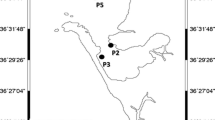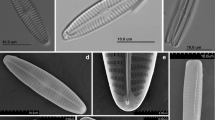Abstract
The toxicity associated with suspended sediments from the Rhone River (Switzerland-France) was determined with three acute bioassays. Large volume water samples were centrifuged for recovery of suspended solids in November 1989; one sample was taken as a control upstream from Lake Geneva and the 9 remainder downstream from Geneva to the Mediterranean Sea, with a single sample of the major tributary the Saône at Lyon. Heavy metals (Hg, Cd, Cr, Cu, Ni, Pb, Zn) and organic contaminants (OCs, PCBs, PAHs) bound to sediment were analysed and extracted by elutriation with filtered lake water and by organic solvent (dichloromethane). Sediment water elutriates were tested with algal fractionation bioassays (AFB) using Lake Geneva ambient phytoplankton, with Daphnia magna and Microtox® acute toxicity tests, whereas organic extracts were utilized in the latter two bioassays to evaluate the potential sediment toxicity.
The bulk analyses of the sediment together with elutriate metal concentrations indicated the highest contamination of sediment downstream of Lyon. Medium contamination appeared for the stations downstream of Geneva, in the Saône River and at the Rhone River mouth. The station upstream of Lyon had low concentrations, comparable to the values in the Upper Rhone. Organic contaminants are mainly observed downstream of Lyon and their concentrations decline onwards to the sea. The bioassays Microtox® on organic extracts and AFB on the elutriates show a similar toxicity trend, but differ in that Microtox was more sensitive to organics whereas the algal test responded predominantly to metals. This difference is believed to be due to the different extraction procedures used, rather than to the tests themselves. Daphnia magna was the least sensitive and appeared to give a broader band response to the observed contaminants in the sediment. The bioassay results when integrated confirm that the biotoxicity trends relate well to the composition of the sediment, a factor which emphasizes the need for battery testing in ecotoxicological assessment.
Similar content being viewed by others
References
Afghan, B.K. & M.A. Forbes 1987. Analytical protocol for monitoring ambient water quality at the Niagara-on-the-Lake and Fort Erie stations. Report National Water Quality Laboratory, Canada Centre for Inland Waters, Burlington, Ontario.
André, B. & C. Lascombe 1988. Qualité du fleuve Rhône. Synthèse des connaissances. Agence de Bassin Rhône-Méditerrannée-Corse, Lyon, 251 pp.
Bulich, A.A., M.W. Greene & D.L. Isenberg 1981. Reliability of the bacterial luminescence assay for determination of toxicity of pure compounds and complex effluents. Aquatic Toxicology and Hazard assessment. Am. Soc. for Testing and Materials STP 737: 338–347.
Burrus, D., R.L. Thomas, J. Dominik & J.P. Vernet 1989. Recovery and concentration of suspended sediment in the Upper Rhone River by continuous flow centrifugation. Hydrological processes 3: 65–74.
Burrus, D., R.L. Thomas, B. Dominik, J.P. Vernet & J. Dominik 1990a. Characteristics of suspended sediment in the Upper Rhone River, Switzerland, including the particulate forms of phosphorus. Hydrological processes 4: 85–98.
Burrus, D., R.L. Thomas, J. Dominik & J.P. Vernet 1990b. Seasonal delivery of the particulate forms of phosphorus to Lake Geneva from the Upper Rhone River. Aquatic Sciences 52: 221–235.
Cairns, J. Jr. & J.R. Pratt 1989. The scientific basis of bioassays. Hydrobiologia 188/189: 5–20.
Campbell, M., G. Bitton, B. Koopman & J.J. Delfino 1992. Comparison of sediment extraction procedures and exchange solvents for hydrophobic compounds based on inhibition of bioluminescence. Environ. Toxicol. Water Qual. 7, in press.
Daniels, S.A., M. Munawar & C.I. Mayfield 1989. An improved elutriation technique for bioassessment of sediment contaminants. Hydrobiologia 188/189: 619–631.
Dutka, B.J. & K.K. Kwan 1988. Battery of screening tests approach applied to sediment extracts. Toxicity Assessment 3: 303–314.
Dutka, B.J., R. Tuominen, L. Churchland & K.K. Kwan 1989. Fraser River sediments and waters evaluated by the battery of screening tests technique. Hydrobiologia 188/189: 301–315.
Favarger, P.Y. 1982. Simultaneous determination of 31 elements in lacustrine sediments by ICP. In Analytical Techniques in Environmental Chemistry 2, Pergamon Ser. Environ. Sci., 7: 371–376.
Frank, R., R.L. Thomas, M. Holdrinet, R.K. McMillan, H.E. Braun & R. Dawson 1981. Organochlorine residues in suspended solids collected from mouths of Canadian streams flowing into the Great Lakes 1974–1977. J. Great Lakes Res. 7: 363–381.
Giesy, J.P. & R.A. Hoke 1989. Freshwater sediment toxicity bioassessment: Rationale for species selection and test design. J. Great Lakes Res. 15: 539–569.
Golterman, H.L., P.G. Sly & R.L. Thomas 1983. Study of the relationship between water quality & sediment transport. Technical Papers in Hydrology 26, United Nations Educational, Scientific and Cultural Org., Paris, 231 pp.
Hach, W.R. & Ott, W.L. 1968. Determination of submicrogram quantities of mercury by atomic absorption spectroscopy. Anal. Chem. 40: 2085–2087.
Horowitz, A.J., K.A. Elrick & R.C. Hooper 1989. A comparison of instrumental dewatering methods for the separation and concentration of suspended sediment for subsequent trace metal analysis. Hydrological processes 2: 163–184.
Larbaigt, G., M. Bonnefille, D. Peyre & A. Tabonnet 1991. Détermination du niveau de toxicité des sédiments de rivière par le test de bioluminescence bactérienne. Rev. Sciences de 'Eau, in press.
McMillan, K. & R.L. Thomas 1977. Large volume water sampling for recovery of suspended solids in Great Lakes tributaries. Abst. 20th Conf. of Great Lakes Res., Ann Arbor, Michigan.
Munawar, M., A. Mudroch, I.F. Munawar & R.L. Thomas 1983. The impact of sediment-associated contaminants from the Niagara River mouth on various size assemblages of phytoplankton. J. Great Lakes Res. 9: 303–315.
Munawar, M. & R.L. Thomas 1989. Sediment toxicity testing in two areas of concern of the Laurentian Great Lakes: Toronto (Ontario) and Toledo (Ohio) harbours. Hydrobiologia 176/177: 397–409.
Munawar, M., R.L. Thomas, W.P. Norwood & A. Mudroch 1985. Toxicity of Detroit River sediment-bound contaminants to ultraplankton. J. Great Lakes Res. 11: 264–274.
Nebecker, A.V., M.A. Cairns, J.H. Gakstatter, K.W. Malueg, G.S. Schuytema & D.F. Krawczyk 1984. Biological methods for determining toxicity of contaminated freshwater sediments to invertebrates. Environmental Toxicology and Chemistry 3: 617–630.
Nicollerat, S., D. Rossel & J. Tarradellas. Solvent effect on the toxicity of a hydrophobic compound to Daphnia magna. In preparation.
OECD 1987. Guidelines for testing chemicals. Daphnia sp. acute immobilization test and reproduction test (Test 202). Org. Economic Cooperation and Development, Paris, 16 pp.
Ongley, E.D. P.D. Blachford 1982. Application of continuous flow centrifugation to contaminant analysis of suspended sediment in fluvial systems. Environ. Techn. Letters 3: 219–228.
Ongley, E.D. & R.L. Thomas 1989. Dewatering suspended solids by continuous flow centrifugation: Practical considerations. Hydrological processes 3: 255–260.
Rossel, D., M.A. Echeverria & J. Tarradellas 1991. Application de tests écotoxicologiques à des extraits de sédiments du Lac Léman. In 3ème Conf. Int. Limnologues d'Expression Française, ed. J.P. Vernet, 202–205, Morges, Switzerland.
Santiago, S. & R.L. Thomas 1992. Bioavailability of phosphorus bound to suspended sediment in some rivers tributary to Lake Geneva. J. Great Lakes Research, in press.
Santiago, S., R.L. Thomas & C. Corvi 1989. Bioavailability of sediment-associated contaminants from Geneva watershed to natural phytoplankton. In Int. Conf. Heavy Metals in the Environment, ed. J.P. Vernet, 2: 270–273. Edinburgh: CEP Consultants.
Santiago, S., R.L. Thomas, J.L. Loizeau, P.Y. Favarger & J.P. Vernet 1990. Further discussion on the intercomparison of the trace metal concentrations and particle size of fluvial sediment recovered from two centrifuge systems. Hydrological processes 4: 283–287.
Santiago, S., R.L. Thomas, L.J. Loizeau, G. Larbaigt, C. Corvi, D. Rossel, J. Tarradellas, L.H. McCarthy & J.P. Vernet 1991. Particle size characteristics of suspended and bed sediments in the Rhone River. Hydrological processes, in press.
Santiago, S., R.L. Thomas, C. Corvi, D. Rossel, J. Tarradellas, G. Larbaigt, D.J. Gregor, P.Y. Favarger & L.H. McCarthy 1992. Nutrient, heavy metal and organic micropollutant composition of suspended and bed sediment in the Rhone River. In press.
Shear H. & A.E. Watson 1977. The fluvial transport of sediment-associated nutrients and contaminants. International Joint Commission, Windsor, Ontario, 309 pp.
Sloterdijk, H., L. Champoux, V. Jarry, Y. Couillard & P. Ross 1989. Bioassay responses of micro-organisms to sediment elutriates from the St. Lawrence River (Lake St. Louis). Hydrobiologia 188/189: 317–335.
Tessier, A. & P.G. Campbell 1987. Partitioning of trace metals in sediments: Relationships with bioavailability. Hydrobiologia 149: 43–52.
Thomas, R.L. & R. Frank 1982. PCB's in sediment and fluvial suspended solids in the Great Lakes. Proc. Int. Workshop on PCB's in the Great Lakes. Univ. Toronto, ecember 1981. 14: 245–267.
U.S.E.P.A./Corp. of Engineers 1977. Ecological evaluation of proposed discharge of dredged material into ocean waters. U.S. Environmental Protection Agency/U.S. Army Corp. of Engineers, Technical Committee on Criteria for Dredged and Fill Material, Vicksburg, Mississippi, 24 pp.
Vernet, J.P., G. Scolari & F. Rapin 1976. Teneurs en métaux lourds des sédiments de rivières suisses, du Rhône français et de ses principaux affluents. Bull. Bur. Rech. Géol. Min., 2ème sér., sect. III 1/2: 31–45.
Author information
Authors and Affiliations
Rights and permissions
About this article
Cite this article
Santiago, S., Thomas, R.L., Larbaigt, G. et al. Comparative ecotoxicity of suspended sediment in the lower Rhone River using algal fractionation, Microtox® and Daphnia magna bioassays. Hydrobiologia 252, 231–244 (1993). https://doi.org/10.1007/BF00005472
Received:
Revised:
Accepted:
Issue Date:
DOI: https://doi.org/10.1007/BF00005472




